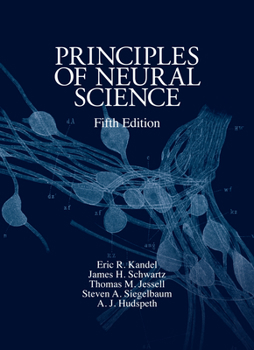Principles of Neural Science, Fifth Edition
Select Format
Select Condition 
Book Overview
Publisher's Note: Products purchased from Third Party sellers are not guaranteed by the publisher for quality, authenticity, or access to any online entitlements included with the product.
Now updated: the definitive neuroscience resource--from Eric R. Kandel, MD (winner of the Nobel Prize in 2000); James H. Schwartz, MD, PhD; Thomas M. Jessell, PhD; Steven A. Siegelbaum, PhD; and A. J. Hudspeth, PhD
A Doody's Core Title for 2019
900 full-color illustrations
Deciphering the link between the human brain and behavior has always been one of the most intriguing--and often challenging--aspects of scientific endeavor. The sequencing of the human genome, and advances in molecular biology, have illuminated the pathogenesis of many neurological diseases and have propelled our knowledge of how the brain controls behavior.
To grasp the wider implications of these developments and gain a fundamental understanding of this dynamic, fast-moving field, Principles of Neuroscience stands alone as the most authoritative and indispensible resource of its kind.
In this classic text, prominent researchers in the field expertly survey the entire spectrum of neural science, giving an up-to-date, unparalleled view of the discipline for anyone who studies brain and mind. Here, in one remarkable volume, is the current state of neural science knowledge--ranging from molecules and cells, to anatomic structures and systems, to the senses and cognitive functions--all supported by more than 900 precise, full-color illustrations. In addition to clarifying complex topics, the book also benefits from a cohesive organization, beginning with an insightful overview of the interrelationships between the brain, nervous system, genes, and behavior. Principles of Neural Science then proceeds with an in-depth examination of the molecular and cellular biology of nerve cells, synaptic transmission, and the neural basis of cognition. The remaining sections illuminate how cells, molecules, and systems give us sight, hearing, touch, movement, thought, learning, memories, and emotions.
The new fifth edition of Principles of Neural Science is thoroughly updated to reflect the tremendous amount of research, and the very latest clinical perspectives, that have significantly transformed the field within the last decade.
Ultimately, Principles of Neural Science affirms that all behavior is an expression of neural activity, and that the future of clinical neurology and psychiatry hinges on the progress of neural science. Far exceeding the scope and scholarship of similar texts, this unmatched guide offers a commanding, scientifically rigorous perspective on the molecular mechanisms of neural function and disease--one that you'll continually rely on to advance your comprehension of brain, mind, and behavior.
FEATURES
The cornerstone reference in the field of neuroscience that explains how the nerves, brain, and mind functionClear emphasis on how behavior can be examined through the electrical activity of both individual neurons and systems of nerve cellsCurrent focus on molecular biology as a tool for probing the pathogenesis of many neurological diseases, including muscular dystrophy, Huntington disease, and certain forms of Alzheimer's diseaseMore than 900 engaging full-color illustrations--including line drawings, radiographs, micrographs, and medical photographs clarify often-complex neuroscience conceptsOutstanding section on the development and emergence of behavior, including important coverage of





